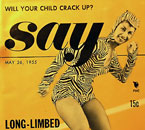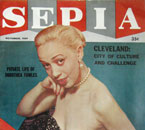Photographs have the kind of authority over imagination today, which the printed word had yesterday, and the spoken word before that. They seem utterly real.
–Walter Lippmann, Public Opinion (1922)
The picture magazines of the 1940s did for the public what television did for audiences of the 1950s: they opened new windows in the mind and brought us face to face with the multicolored possibilities of man and woman.
-John H. Johnson
The pictorial magazines of the Johnson Publishing Company—Ebony, Jet, Tan, and Ebony Jr., among others—were pivotal in promoting affirmative black imagery in popular culture. Pointing to the slow but significant rise of the black middle class in the period following World War II, the company’s founder, John H. Johnson, adhered to a simple business philosophy: persuade companies and businesses that it was in their economic “self-interest” to advertise in his magazines and reach out to African American consumers. John Johnson, more successfully than any other businessman of his era, capitalized on this desire to remake the image of black people in popular culture.
The visual revolution he initiated inspired a host of other, often short-lived black pictorial magazines, including Hue, Our World, Say, Sepia, and The Urbanite. These publications emphasized photo-essays about African American achievement and celebrity but also reported on the harsh reality of racism. The magazines’ upbeat content catered to subscribers and sponsors alike, providing readers with pictures that defied stereotypes and advertisers with stories that sold the idea of black success, stability, and affluence.
Image Credits/Captions (Click on thumbnails for full image)
Say, 26 May, 1955. 6 x 4 1/2 x 1/8 in. Collection of Civil Rights Archive/CADVC-UMBC, Baltimore, MD, Anonymous Gift, 2009.5
Sepia, November 1959. 13 3/16 x 10 3/16 x 1/8 in. Collection of Civil Rights Archive/CADVC-UMBC, Baltimore, MD, 2005.206
Our World, August 1954. 13 3/8 x 10 5/16 x 3/16 in. Collection of Civil Rights Archive/CADVC-UMBC, Baltimore, MD, 2005.70


